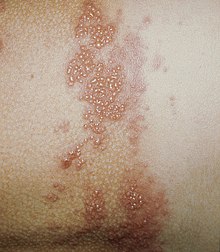Shingles
Herpes zoster, also known as shingles, is a viral disease that mainly appears as a painful strip-shaped skin rash with blisters or skin vesicles on one side of the body. The vesicular rash is caused by the spread of inflammation from a nerve (e.g. a ganglion) to the surrounding dermatome (skin area).
The disease is caused by the varicella-zoster virus (VZV), which belongs to the herpesviridae family. It usually occurs in older people or those with a weakened immune system (due to stress, as a result of other diseases such as AIDS or due to special immunosuppressive therapy). The virus is often transmitted in childhood and causes chickenpox in the primary infection. Herpes zoster is always an endogenous, i.e. internally generated reactivation of an old VZV infection (pathogen persistence).
![]()
This article or paragraph presents the situation in Germany. Help describe the situation in other countries.
Since the beginning of 2018, the zoster vaccine Shingrix has been approved to prevent the disease herpes zoster. The approval applies to all persons aged 50 years and older or 18 years and older with an increased risk of herpes zoster. In December 2018, the STIKO had recommended varicella vaccination for people 60 years and older. Since this vaccination became a benefit of the statutory health insurance in May 2019, the vaccinations had more than doubled by 150 percent to 217,000 vaccine doses in the following month.

Shingles (Herpes Zoster)

Shingles on the neck along the C3 with pain behind the right ear
Etymology
The popular German term "Gürtelrose" (shingles) originated because the reddish rash in particularly pronounced manifestations starts from the spine and wraps itself around the body on one side or completely in the shape of a belt, where it causes erysipelas. At the same time erysipelas is an old-fashioned term for an acute, locally limited skin inflammation, which was often used undifferentiated for different clinical pictures of different causes.
The term herpes zoster (formerly herpes zoster) derives from ancient Greek ζωστήρ zoster ('girdle' in reference to the "girdle-like" course first found in Pliny the Elder). Compare also ancient Greek ἕρπειν herpein, German 'kriechen'.
In English, herpes zoster is called shingles, which in turn is borrowed from the Latin cingulum for 'girdle', in French zona and zoster.
Old names include fever lichen as well as "fire belt" (Latin zona ignea), in France and England also zone or zona, and the otherwise for ergotism ("Antonius fire") used term Ignis sacer ("sacred fire"). Herpes zoster was formerly also called belt rash and belt lichen as well as zona serpiginosa.
The abbreviated technical terms zoster (for herpes zoster, triggered by the varicella-zoster virus (VZV)) and herpes (for herpes simplex, a disease caused by herpes simplex viruses) are often confused, although they are two different diseases that differ significantly in the pathogen and especially in the secondary diseases.
Pathophysiologically, herpes zoster has also been contrasted as poliomyelitis acuta posterior to poliomyelitis acuta anterior (polio).
Epidemiology
In Germany, about 350,000 to 400,000 people contract herpes zoster every year, about 2/3 of them are over the age of 50. The most recent study for Germany showed that more than 306,000 people over the age of 50 contract herpes zoster every year. This results in an incidence of 9.6 per 1000 people per year.
Since around 98% of the population had contact with the varicella-zoster virus by the age of 40, usually either clinically manifest in the form of chickenpox or in the form of a silent infection, almost all adults are at risk. This is due to the fact that the varicella-zoster viruses remain inactive in the body for life. Around 25 to 30% of the population will experience zoster in their lifetime. Among 85-year-olds, 50% have already experienced a disease. The changes brought about by the introduction of vaccination in the first year of life, which has been recommended since 2004, are not yet known.
The likelihood of herpes zoster infection increases with age, and women are more likely to contract the disease. Other risk factors are diseases that are associated with a weakening of the immune system:
- Diseases of the immune system significantly increase the risk, such as lymphoma (odds ratio OR = 3.9), myeloma (OR = 2.2), HIV infection (OR = 5.1), stem cell transplantation (OR = 13.5).
- Immunosuppressive drugs: oral corticosteroids (OR = 1.5), Janus kinase inhibitors (relative risk 2.0 - 3.2), other immunosuppressants (OR = 1.8).
- Diseases with indirect weakening of the immune system: rheumatoid arthritis (OR = 1.5), inflammatory bowel diseases (OR = 1.4), chronic obstructive pulmonary disease (COPD, OR = 1.3), asthma, chronic renal insufficiency, type I diabetes
- Further risk factors are a family history (OR = 1.7), previous herpes zoster disease (OR = 1.8), but also sleep disorders (OR = 2.5), depression (OR = 3.8) and stress (OR = 2.8).
Questions and Answers
Q: What is herpes zoster?
A: Herpes zoster is a disease in humans that is also known as shingles or zona.
Q: What causes herpes zoster?
A: The same virus that causes chickenpox also causes shingles.
Q: What are the symptoms of herpes zoster?
A: The symptoms of herpes zoster include pain and a rash with blisters.
Q: How can you reduce the risk of shingles?
A: The shingles vaccine can reduce the risk of shingles.
Q: Can antivirus medicine help with herpes zoster?
A: Yes, antivirus medicine can reduce the seriousness and duration of shingles if started within 3 days of the rash.
Q: Is herpes zoster contagious?
A: Yes, people who have not had chickenpox can catch the virus from someone with shingles, although they will develop chickenpox instead of shingles.
Q: How is herpes zoster treated?
A: Treatment for herpes zoster involves easing the symptoms, such as using pain relief medication, and taking antivirus medicine if started within 3 days of the rash.
Search within the encyclopedia